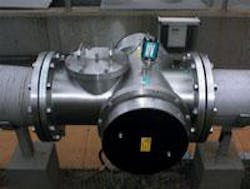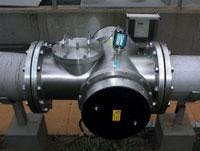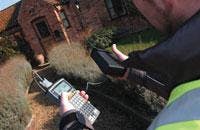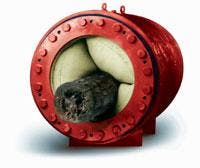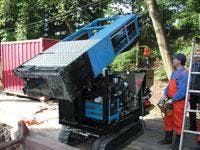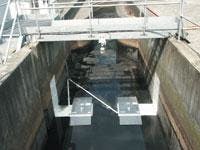Technologies & Products
UV system design based on minimum required dose
Designing ultraviolet disinfection systems based on average UV dose is inefficient, concluded Ben F. Kalisvaart of the Netherlands-based Berson UV-techniek, in a paper presented at the recent International UV Association Congress in Vienna, Austria. The paper, "The impact of Minimum UV Fluence on Microbiological Reduction in Wastewater Disinfection," outlined the findings from a number of independent studies and trials comparing UV dose (fluence) with microbial survival rates in open-channel, low pressure UV treatment reactors and medium pressure, in-pipe UV systems.
Kalisvaart concluded that it is much more effective to design UV systems based on the minimum required UV dose - the minimum dose of UV required to reduce microorganism levels in wastewater by a factor 1,000 times or higher. "This minimum dose will vary depending on local conditions such as flow volume and the amount of organic and inorganic material in the wastewater. The optimum dose will therefore be unique to each site. Each UV installation needs to be designed individually with lamp distances set according to specific local conditions to ensure effective disinfection at all times."
Microorganisms receiving the lowest UV fluence in open-channel, low pressure UV systems (i.e. those microorganisms furthest away from UV lamps) are actually capable of repairing their UV-damaged DNA, contends Kalisvaart. The findings, he explained, showed that in low pressure, open-channel UV reactors a small but significant percentage of wastewater - that receiving a UV dose below about 10 mJ/cm2 - experiences a surprisingly low rate of microbial reduction, and in some cases not at all.
Computational fluid dynamics modelling demonstrated that the laminar flow patterns common to open-channel UV systems often produce wide variations in UV dose within treatment channels, with those microorganisms receiving the lowest UV doses being more likely to undergo DNA repair.
The bersonInLine range is designed to produce a turbulent flow through the treatment chamber, resulting in a more even spread of UV fluence. The systems use the bersonMultiWave medium pressure UV lamp, which emits a broad spectrum of UV at wavelengths that act on microorganisms' DNA and other molecules like DNA repair enzymes, resulting in permanent, non-repairable cellular damage.
Berson UV-techniek
Nuenen, Netherlands
JWC wins 3rd WEF Tech Award
JWC Environmental won the Water Environment Federation 2003 Innovative Technology Award in the solids handling/disposal category with its Honey Monster® Septage Receiving System.
This year's winner marks the company's third award since 1997.
The award will be presented to JWC during WEFTEC, the international
water quality technical conference and exhibition, which will be held in Los Angeles, California during 11-15 October. The award is presented to WEF members that introduce the most innovative new product or service related to the construction, operation or maintenance of water pollution control facilities.
The Honey Monster system met all the criteria due to its combination of solids reduction via two-shafted grinding technology, the washing, compacting and de-watering capabilities of an auger conveyer system and its advanced control system. The system allows a cleaner method of handling septage truck waste that can empty an entire truck in 5 to 15 minutes. The system is available with an optional metering and billing control system that controls access, monitors seepage flow and provides billing information to septage haulers and the plant.
JWC Environmental
Costa Mesa, California, USA
Invensys demonstrates intelligent metering systems
IWEX visitors will be able to make real time meter readings via a range of interrogation solutions from the Invensys portfolio as data is transmitted during the IWEX exhibition, which will be held in Birmingham, England, from 11-13 November 2003. The company's intelligent metering systems range from domestic, commercial and industrial water and gas meters, including sub-metering and automatic metering (AMR) systems. These systems will also be showcased at IWEX.
The Meitwin compound water meter's design eliminates the need for left and right models and features three-in-one measuring cartridges that reduce stockholding costs and quicken installation.
Invensys' second generation pulse and data system offers a retrofit data unit that provides a flexible platform for data management. The Sacre, a fixed radio solution, allows remote interrogation of water, gas and electricity meters from a PC equipped with a standard office modem and Invensys software.
Invensys Metering Systems
London, UK
Megaflex pinch valves for influent control
Type A Megaflex Pinch Valves are designed for influent control with a full-port opening, no moving parts and no external actuator. Available in sizes to 84", Megaflex valves save money through lower pumping costs, zero maintenance and increased reliability because they do not clog, according to Red Valve Company. Red Valve's full line of pinch valves includes check valves, knife gate valves, pressure sensors, air diffusers and rubber products.
Red Valve Company
Carnegie, Pennsylvania, USA
Data management solution saves time
Avatech Solutions' Implementation of the Cyco AutoManager Meridian allows for 18,000 disparate drawings to be shared across the Hampton Roads Sanitation District (HRSD) at anytime via the Internet. The time needed to fulfil document requests dropped from days to minutes, and the lean three-person team at the HRSD in Hampton, Virginia, USA, can now manage a doubled workload without having to hire more staff.
Every second counts when repairing a breakdown in the municipality because 1.5 million people rely on the municipality for wastewater collection and treatment services. The system can now quickly pull the right data from an infrastructure that consists of 500 miles of pipeline connecting 101 pumping stations and 13 treatment plants.
Avatech Solutions
Baltimore, Maryland, USA
Orbimatic adds retrofit capability
Orbimatic recently improved the manufacture of its orbital welding power supplies to allow nearly all new customers to retrofit Orbimatic power supplies with competitive weld heads. Orbimatic increased capacity of the internal memory that now allows machines to store more than 2,000 4-level welding procedures, which will be standard on all new systems supplied.
The Weld Head Control Module can be ordered as an optional extra that allows the Orbimat power supplies to be used with not just tacho-feed weld heads, but also those that use an electronic pulsed feedback.
Orbimatic GmbH
Peterborough, UK
Compact package combines all ring main controls
The quality of purified water must be maintained while distributing water to user points, which requires different process components to sure efficient delivery and microbial control. The Christ Loopo provides these components in a compact packaged ring main distribution and disinfection system.
Loopo combines various components; a speed regulated booster pump, an electrolytic ozone generator with ozone measuring devices, together with a UV irradiator for ozone destruction, flow and conductivity meters, in addition to an optional printer on the control panel for quality assurance. A double plate heat exchanger can be incorporated to control ring main heating. Loopo units for 5,000 to 20,000 l/hr are available.
Loopo has been designed and built to operate with the Christ Osmotron packaged water purification system, but can be installed with other systems. Maintaining microbial purity is ensured by the presence of ozone, produced by the Christ Steritron as the first process step. The Steritron generates an average ozone concentration of less than 0.1 mg/l, but sufficient to ensure a microbial count less than 10 cfu/100 ml at the point of use. UV irradiation then decomposes the ozone.
Christ, Christ Water Technology Group
Stuttgart, Germany
Liquid polymer blending unit features PLC
The compact Semblex® system, a liquid polymer blending unit enhanced with the programmable logic micro-controller, the Semblex Polymax Series L, reduces system costs, according to Greg Kriebel, Semblex product manager for Severn Trent Services.
Kriebel explained: "Polymers can represent a significant part of a treatment plant's chemical cost. Properly mixed and activated polymers can improve process performance and reduce chemical costs."
Polymers have long been used in the treatment of water and wastewater to attract, adsorb and ultimately remove suspended particles. Since polymer handling is critical to the process, polymers must be carefully mixed and fed into the treatment process.
The Semblex system introduces and activates the polymer solution using a two-stage tapered mixing system. Employing a thin film blending technology, the system features clear, in-line mixing elements to provide visual confirmation of the mixing/blending process.
Equipped with a programmable logic micro-controller, the system features standard pre- and post- auto-flush cycles; a built in LCD operator interface screen; and on-board diagnostics. The standard auto-flush eliminates clogging and reduces maintenance costs. A built-in LCD screen and on-board diagnostics assist with set-up, maintenance, and troubleshooting the system.
Severn Trent Services
For Washington, Pennsylvania, USA
Foul water sampler helps airport gain discharge consent
The Aquamatic wastewater sampler is helping Birmingham International Airport (BIA) to monitor foul water discharges and comply with agreed consent limits laid down by the UK company Severn Trent Water Ltd.
During the winter months, when glycol-based chemicals are applied to aircraft, and potassium-based de-icants are applied to airfield areas for safety reasons, the airport's flood and pollution control system diverts water run-off into polluted water holding tanks. From these, the airport's Environment Protection staff and Severn Trent Water collect samples from the Aquamatic sampler on a daily basis if required to monitor discharge.
The water company then sets its charges accordingly, depending on the level of contaminants contained in the foul water, which is discharged by gravity feed into the local relief sewer for treatment at Severn Trent's wastewater plant in nearby Coleshill. The system contains two water holding tanks 4.2-m-deep, each able to hold 3,750,000 litres.
Aquamatic
Manchester, England
Mini-bore unit installs trenchless connection
The new mini-bore unit Grundopit-Compact unit using the steerable technique can be used to install drinking water and sewage pipes when service lines from the main line into the utilities room of an existing building need to be replaced. The steerable technique is used for house connections, which are normally difficult to access or have a difficult route.
The drive, mixing unit and bore rig with rod box are installed on a track-mounted undercarriage as a combined bore, drive and headstock unit. This way the whole bore unit can be transported to difficult to access jobsites. Drive and boring operations are regulated via remote control. The pivotable rig boom with integrated bore unit is situated on the carriage, which can be driven out horizontally in the transport position and vertically in the working position. The frame with bore unit is lowered hydraulically with a lifting device into the tight 800-mm by 500-mm working pit, and after fixing just above the service line, is ready for use in the required bore direction.
The drill rod is placed into the rig from above and lowered down to the bore axis via lift transportation where it is automatically screwed tightly together. The house connection, pulled-in reverse mode, is fitted with the necessary service ready for connecting to the mains supply. Service house connections to depths of 1.5 metres can be produced using this method and connecting technique.
Tracto-Technik GmbH
Lennestadt, Germany
Flat electromagnetic flowmeter solves flume problems
ChannelMag, a flat electromagnetic flowmeter manufactured by Advanced Flow Technology Inc (AFTCo) and marketed by Arkon Flow Systems, ensures the correct treatment of the total inflow to the Esholt sewage treatment works in the UK. The meter was installed in a 3-m-wide inlet channel at the Esholt works for Yorkshire Water in less than four hours from full channel to full channel again.
The reason for fitting ChannelMag is that despite having an accurate, acceptable and verified flume in the inlet channel, it gave incorrect data when the effluent backed up due to a downstream blockage. The level would rise without flow, which would be interpreted as increasing flow rate - resulting in over-treatment, excess costs, wasted chemicals and incorrect reporting on consent limits to the Environment Agency. Tests after installation showed perfect correlation with the flume during normal flow conditions.
ChannelMag is an area velocity meter that measures the average velocity of water flowing over it. An ultrasonic sensor measures the height. Enhancement plates are set to the exact channel width during calibration. The meter operates with Pulsed AC at high frequency to energise the coils, which can be up to 5 amps at 33 Hz. The result is a high energy field with a superior signal to noise ratio, hence the meter never needs cleaning irrespective of the build up of grease, fat, algae or calcium carbonate deposits on the electrodes. It also means that the strong magnetic field will reach every part of flowing media in the cross section of the channel - effectively turning the channel into a rectangular full bore meter.
Arkon Flow Systems
Elstree, Herts, UK
Northwestern University to license perchlorate removal technology
Applied Process Technology agreed to license and commercialise a new perchlorate removal technology from North-
western University. The hydrogen-based membrane biofilm reactor (MBfR) removes a host of toxic compounds from contaminated water by converting them to innocuous products, not by concentrating them as waste by-products. The MBfR uses naturally occurring bacteria that reduce the contaminants to innocuous forms when they are fed hydrogen gas.
The MBfR removes nitrate and perchlorate, a chemical used primarily as a rocket fuel or propellant. Perchlorate has become a great concern because it has been detected in a growing number of drinking water sources in California, has been reported in the water supplies of 20 states across the US, and is not easily removed by traditional treatment methods.
Under its option agreement with Northwestern, Applied will continue its evaluation and scale-up potential of the MBfR, which has been demonstrated to reduce a wide variety of compounds in bench-scale and pilot-scale applications, for use at full-scale treatment sites. Applied then plans to license and fully commercialise the technology. North-
western University is located in Evanston, Illinois, USA.
The MBfR complements Applied's line of HiPOx™ advanced oxidation treatment systems, a destructive technology that is effective for the treatment of chemicals that respond to advanced oxidation chemistries. The MBfR developed at Northwestern is a reductive technology that is able to destroy contaminants that cannot be oxidised. "These two very different treatment solutions will enable Applied to address a vast range of contaminant issues at a given treatment site without generating waste concentrates," said Terry Applebury, president of Applied.
Applied Process Technology, Inc.
Pleasant Hill, California, USA
Cannibal process reduces industrial sludge by 95%
The Cannibal™ solids reduction process reduces or eliminates the amount of sludge produced by activated sludge wastewater treatment systems, and costs associated with sludge wasting, dewatering and removal. This patented technology can be used for new plant designs or retrofitted to existing facilities.
"The Cannibal process technology decreases biosolids to an almost insignificant amount," said Betty Ann Curtis, product manager for USFilter Envirex Products. Biosolids destruction is accomplished through an interchange between the activated sludge process and the Cannibal side stream bioreactor. This interchange recycle between the aerobic treatment process and the non-aerobic bioreactor continuously selects for low yield bacteria and breaks down the biosolids until they are destroyed.
Users can expect a significant reduction in the costs associated with sludge thickening and dewatering equipment, sludge storage and holding tanks, anaerobic or aerobic digesters, polymer feed equipment costs, and in sludge holding, hauling and disposal costs.
USFilter Envirex Products
Waukesha, Wisconsin, USA
